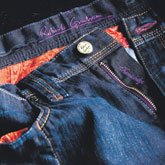Premium-Denim Prices on the Rise
Premium-denim prices are back in style. When the recession put a dent in consumer spending, many denim manufacturers reacted by reducing prices. But it seems that the days of the $178 premium jean are gone. With a stronger economy and more intricate designs, retailers are see-ing designer jeans climb back up to prerecession pricing in the $200 to $300 range.
quot;We are seeing companies like Diesel and G-Star that used to be moderate and now they are both providing more premium washes in denim that cost above the $200 and $250 range,quot; said Don Zuidema, co-owner of men’s ap-parel store LASC in West Hollywood, Calif.
Unique details such as intricate embellishments, hand abrasion, hand stitching and an enhanced fit are attracting customers who are willing to spend more than they would a year ago, according to Zuidema.
quot;The consumer is willing to pay the price if the wash and the details and the fit are right. It’s about perceived value, and in their mind, they can justify that price, whereas maybe a year or so ago, people walked away from that.quot;
LASC offers jeans that range in price from $150 to $395, with at least three brands in the $300 range, including Diesel; G-Star; and Diesel Black Gold, Diesel’s higher-end denim line.
Jeff Shafer, designer and owner of Washington-based Agave Denim, which is carried in L.A. boutiques such as T. Peterson and Jimmy Au’s, said the price of his premium jeans has increased about 15 percent over the past year.
quot;The market is better, and people are feeling more secure. After the drop in the economy, retailers reacted by dropping prices at the cost of the product, and consumers got bored. Now the consumers want more and are willing to pay if the product is exceptional.quot;
His Agave jeans retail for $155 to $300, with most pairs averaging from $195 to $255 and $300 for men’s selvage denim.
Out of 98 brands listed on its website, Southern California–based American Rag carries 30 brands of premium jeans priced at $200 and above, including PRPS, a label that retails as high as $500. American Rag sales associate Candice Dennis said she saw prices start increasing about a year ago and that the store’s average price is now $275.
English cycling brand Rapha has developed $245 jeans made with quot;performance denimquot; for riding, brands such as True Religion provide selvage denim for $569, and luxury label Balmain offers high-fashion jeans for $2,120.
True premium denim only has to do with better product, according to Shafer, so the increased use of higher-end fabrics and more elaborate washes and green technology has pushed prices up.
quot;The word ’premium’ in and of itself implies better and higher quality.quot; Shafer said. quot;To me, making premium denim means using premium textiles from mills in Europe and Japan and some American mills. It means washing them in places that have laws against environmental and labor abuses. It means delivering a product that justifies the higher price tag. Some designer denim is premium, and some is ordinary. It has to do with the integrity of the product and the supply chain.quot;
According to Michael Buckley, chief executive officer of menswear company Robert Graham and former president of True Religion, novelty is also a driving factor in price. The company is launching a new line of designer denim that retails for $188 to $350 and includes jeans made from denim woven in mills in Italy, Japan and Spain, with laser-designed interior waistbands, embroidered signatures, and zipper pulls in antique brass and nickel.
quot;Today’s consumer who wants a premium jean wants it with a point of difference,quot; Buckley said. quot;It has to have some novelty to the jean. For instance, Robert Graham’s attention to detail and craftsmanship make the collection special, so the consumer doesn’t have a problem paying $250 plus.quot;
Additional factors in higher prices include increases in textile and manufacturing costs and new technologies such as fabrics that hold their shape longer or offer more durability.
The costs of quot;great denimquot; and quot;excellent washesquot; have shot up, and cotton prices and imported fabric from Japan and Italy have also increased sharply, according to Shafer.
Cotton prices spiked to nearly $2.30 per pound this year because of bad crops brought on by inclement weather and increasing world demand. But cotton prices have recently come down over the past three months and are now at $1.08 per pound. Although cotton prices have dropped, Brad Mowry of boutique denim consulting and manufacturing company Olah Inc. said there will be a delay before those decreases are seen at retail. quot;My idea is that retail is still up from the previous cotton-pricing situation, and it does take longer for retail to be affected by the cotton situation,quot; he said.
The higher prices don’t seem to be deterring buyers, according to Zuidema.
quot;It’s a more limited market and more particular consumer, but that consumer is out there again—where they had not been out there before.quot;

























